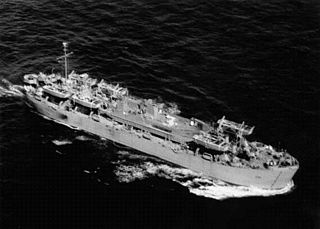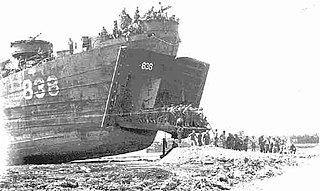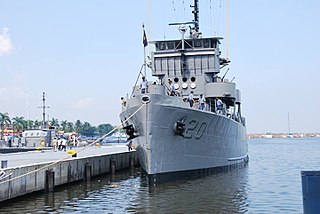
USS Serene (AM-300) was an Admirable-class minesweeper built for the United States Navy during World War II. She served in the Pacific Ocean and was awarded six battle stars. She was decommissioned and placed in reserve in 1946. In January 1964, the former Serene was transferred to South Vietnam as RVNS Nhật Tảo (HQ-10) in the Republic of Vietnam Navy. She was sunk in January 1974 during combat with Chinese forces in the Battle of the Paracel Islands.

USS Shelter (AM-301) was an Admirable-class minesweeper built for the United States Navy during World War II. After service in the Pacific during World War II, Shelter was decommissioned in June 1946 and placed in reserve. In January 1964, she was transferred to South Vietnam for service in the Republic of Vietnam Navy as RVNS Chi Linh (HQ-11). She remained in South Vietnamese service until the collapse of that country in 1975. Chi Linh was one of several ships that fled from South Vietnam to the Philippines. She was then commissioned into the Philippine Navy in April 1976 as RPS Datu Tupas (PS-18), named after a chieftain of Cebu. The ship's fate is not reported in secondary sources.

USS Forster (DE-334) was an Edsall-class destroyer escort built for the U.S. Navy during World War II.

USS Krishna (ARL-38) was one of 39 Achelous-class landing craft repair ships built for the United States Navy during World War II. Named for Krishna, she was the only U.S. Naval vessel to bear the name, and only one of three ships to be named after a Hindu deity.

USS Coconino County (LST-603), originally USS LST-603, was a United States Navy LST-542-class tank landing ship built for the United States Navy during World War II and in commission from 1944 to 1955 and from 1966 to 1969. Named after Coconino County, Arizona, she was the only U.S. Navy vessel to bear the name.

USS Jerome County (LST-848) was an LST-542-class tank landing ship built for the United States Navy during World War II. Named after Jerome County, Idaho, she was the only U.S. Naval vessel to bear the name.

USS Garrett County (LST-786) was an LST-542-class tank landing ship built for the United States Navy during World War II. Named after Garrett County, Maryland, she was the only U.S. Naval vessel to bear the name.

USS Hunterdon County (LST-838) was an LST-542-class tank landing ship built for the United States Navy during World War II, and later reconfigured and recommissioned for riverine warfare during the Vietnam War. Named after Hunterdon County, New Jersey, she was the only U.S. Naval vessel to bear the name.

USS Maricopa County (LST-938) was an LST-542-class tank landing ship built for the United States Navy during World War II. Like many of her class, she was not named and is properly referred to by her hull designation. She was later named after Maricopa County, Arizona, she was the only US Naval vessel to bear the name.

USS Yakutat (AVP-32) was a United States Navy Barnegat-class small seaplane tender in commission from 1944 to 1946. Yakutat tended seaplanes in combat areas in the Pacific during the latter stages of World War II. After the war, she was in commission in the United States Coast Guard from 1948 to 1971 as the Coast Guard cutter USCGC Yakutat (WAVP-380), later WHEC-380, seeing service in the Vietnam War during her Coast Guard career. Transferred to South Vietnam in 1971, she was commissioned into the Republic of Vietnam Navy as the frigate RVNS Trần Nhật Duật (HQ-03). When South Vietnam collapsed in 1975 at the end of the Vietnam War, she fled to the Philippines, where the Philippine Navy took custody of her and cannibalized her for spare parts until discarding her in 1982.

USS Bering Strait (AVP-34) was a United States Navy Barnegat-class small seaplane tender in commission from 1944 to 1946. She tended seaplanes during World War II in the Pacific in combat areas and earned three battle stars by war's end.

USS Cook Inlet (AVP-36) was a United States Navy Barnegat-class small seaplane tender in commission from 1944 to 1946. She tended seaplanes during World War II in the Pacific and earned one battle star for her service. After the war, she was transferred to the United States Coast Guard, and was in commission as the Coast Guard cutter USCGC Cook Inlet (WAVP-384), later WHEC-384, from 1949 to 1971. She saw service in the Vietnam War during her Coast Guard career, receiving two campaign stars for her operations during the conflict. Transferred to South Vietnam in 1971, she operated as the Republic of Vietnam Navy frigate RVNS Trần Quốc Toản (HQ-06) until South Vietnam's collapse in April 1975 at the end of the Vietnam War. She fled to the Philippines and in 1976 was transferred to the Philippine Navy, which never commissioned her, instead using her as a source of spare parts for her sister ships, the Andrés Bonifacio-class frigates, before discarding her in 1982.

BRP Magat Salamat (PS-20) is one of several Miguel Malvar class of patrol corvettes in service with the Philippine Navy. She was originally built as USS Gayety (AM-239), an Admirable-class minesweeper with a similar hull to the PCE-842-class patrol craft produced during World War II. In 1962 she was transferred to South Vietnam for service in the Republic of Vietnam Navy as RVNS Chi Lang II (HQ-08). She was acquired by the Philippine Navy in April 1976 and later on commissioned as Magat Salamat. Along with other ex-World War II veteran ships of the Philippine Navy, she is considered one of the oldest active fighting ships in the world today.

BRP Miguel Malvar (PS-19) is the lead ship of the Malvar class of corvettes of the Philippine Navy. She was originally built as USS Brattleboro PCE(R)-852, a PCE(R)-848-class rescue patrol craft escort for the United States Navy during World War II. In 1966 she was transferred to South Vietnam for service in the Republic of Vietnam Navy as RVNS Ngọc Hồi (HQ-12). She was acquired by the Philippine Navy in April 1976 and later on commissioned as Miguel Malvar after Miguel Malvar y Carpio.
BRP Datu Marikudo (PS-23) was a Malvar-class corvette of the Philippine Navy. She was originally built as USS PCE(R)-853, a PCE(R)-848-class patrol craft for the United States Navy during World War II. She was renamed USS Amherst on 15 February 1956, namesake of both Amherst, Massachusetts and Amherst, Ohio. In February 1970, Amherst was decommissioned and transferred to South Vietnam for service in the Republic of Vietnam Navy as RVNS Vạn Kiếp II (HQ-14). She remained in South Vietnamese service until the collapse of that country in 1975. Vạn Kiếp II was one of several ships that fled from South Vietnam to the Philippines. She was then commissioned into the Philippine Navy on 5 April 1976 and named in honor of Datu Marikudo. Along with other World War II-era ships of the Philippine Navy, Datu Marikudo was considered one of the oldest active fighting ships in the world until her decommissioning.

USS Chincoteague (AVP-24) was a United States Navy seaplane tender in commission from 1943 to 1946 that saw service in the Pacific during World War II. After the war, she was in commission in the United States Coast Guard as the cutter USCGC Chincoteague (WAVP-375), later WHEC-375, from 1949 to 1972. She was transferred to South Vietnam in 1972 and was commissioned into service with the Republic of Vietnam Navy as the frigate RVNS Lý Thường Kiệt (HQ-16), seeing combat in the Battle of the Paracel Islands in 1974. When South Vietnam collapsed at the conclusion of the Vietnam War in 1975, she fled to the Philippines, where she was commissioned into the Philippine Navy, serving as the frigate RPSAndrés Bonifacio (PF-7) from 1976 to 1985.

USS Castle Rock (AVP-35) was a United States Navy Barnegat-class small seaplane tender in commission from 1944 to 1946 which saw service in the late months of World War II. After the war, she was in commission in the United States Coast Guard as the Coast Guard cutter USCGC Castle Rock (WAVP-383), later WHEC-383, from 1948 to 1971, seeing service in the Vietnam War during her Coast Guard career. Transferred to South Vietnam in 1971, she served in the Republic of Vietnam Navy as the frigate RVNS Trần Bình Trọng (HQ-05) and fought in the Battle of the Paracel Islands in 1974. When South Vietnam collapsed at the end of the Vietnam War in 1975, Trần Bình Trọng fled to the Philippines, where she served in the Philippine Navy from 1979 to 1985 as the frigate RPSFrancisco Dagohoy (PF-10).

USS Wachapreague (AGP-8) was a motor torpedo boat tender in commission in the United States Navy from 1944 to 1946, seeing service in the latter part of World War II. After her Navy decommissioning, she was in commission in the United States Coast Guard from 1946 to 1972 as the cutter USCGC McCulloch (WAVP-386), later WHEC-386, the fourth ship of the U.S. Coast Guard or its predecessor, the United States Revenue Cutter Service, to bear the name. In 1972 she was transferred to South Vietnam and served in the Republic of Vietnam Navy as the frigate RVNS Ngô Quyền (HQ-17). Upon the collapse of South Vietnam at the end of the Vietnam War in 1975, she fled to the Philippines, and she served in the Philippine Navy from 1977 to 1985 as the frigate RPSGregorio del Pilar (PF-8) and from 1987 to 1990 as BRP Gregorio del Pilar (PF-12).

The Barnegat class was a large class of United States Navy small seaplane tenders (AVP) built during World War II. Thirty were completed as seaplane tenders, four as motor torpedo boat tenders, and one as a catapult training ship.

The Casco class was a large class of United States Coast Guard cutters in commission from the late 1940s through the late 1980s. They saw service as weather reporting ships in the Atlantic and Pacific Oceans until the early 1970s, and some saw combat service during the Vietnam War.



















